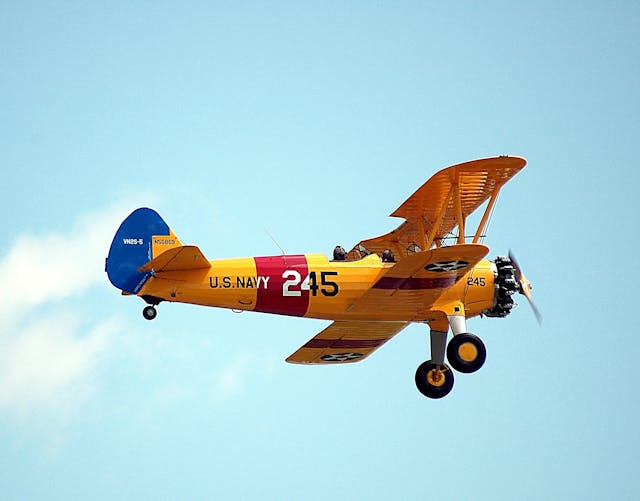
How can you fire through a propeller? Not a lot of planes did this, but the only way a plane can fire through a propeller is by synchronizing the gun and the propeller.
By the start of World War 1 in 1914, powered flight had only existed for 11 years. On December 17th, 1903, Orville Wright flew the Wright Flyer for 36 m. Planes had improved a lot, but they were not initially used for warfare when the war started. Those planes were biplanes and triplanes, and they didn’t have a great range. The majority of planes were only used for reconnaissance. They could fly over the enemy trenches and see what the enemy were up to. They didn’t have radio communication, and unless they could land, the only way to communicate with their forces was to drop messages in weighted bags. These planes were fairly easy targets for the evolving machine guns, and quite a few were shot down. They were made of wood and canvas and had no protection from bullets. About a year into the war, the planes began to have a dual role. They were still used for observation, but they began to drop bombs on the enemy troops. These bombs were dropped by hand over the side of the plane. They also dropped metal darts, which were lethal.
Two years into the war, planes were becoming increasingly important as the technology improved. They could fly further, faster, and higher. At this point, someone realized that if they fitted guns on the planes, they could try to shoot down the other side’s planes. This was the start of aerial warfare. The problem was that the most logical place to fit the gun was directly in front of the pilot so that they could sight down it and aim by pointing the plane at the target, and then fire while they were flying. However, the propeller was in the way. There were two possible solutions. Mounting the guns on the wings or finding a way to get the guns to fire through the propeller. Early planes didn’t have a strong enough frame to mount guns on them. The extra weight would have upset the balance of the plane and possibly even broken the wings. Also, guns fitted on the wings have to be angled so that the bullets meet at a set point in front of the plane. This can make them inaccurate if the enemy plane is too close or too far away. Plus, the only way to fire the gun was to actually pull its trigger. So, the second option it had to be.
The Germans were the first to manage to do it successfully. They used a synchronization gear. The idea was to have the gun only fire when it was between the propeller blades. This proved incredibly difficult. A modern machine gun has a pretty consistent fire rate, but machine guns had only been around for about 30 years, and they weren’t very consistent or reliable. The second problem was that the speed of the plane’s propeller depended on the speed of the plane, the amount of wind, the way they were flying, or the setting of the throttle. Early systems used a camshaft between the propeller and the gun. The propeller was fixed to a disk that had two bumps on it. The bumps depressed a lever, which was attached to the gun. When the propeller span, it fired the gun. These were not very successful, and they jammed a lot. There were a lot of other systems invented, but the main problem was that the guns and the propellers were just not accurate and reliable enough. Even if the gearing was perfect, the gun might misfire. Even the best system would hit the propellers at some point. To that end, pilots began by taping up their wooden propellers. They could survive several hits from their own guns without breaking into pieces. Then, as the guns got more powerful, both armies started to plate their propellers with metal to deflect the bullets.
By the time the Second World War arrived, the systems were much more accurate because they worked on electrical signals, not mechanical gears. However, more planes had wing mounted guns in the Second World War because the engines were easier to make and maintain. Also, planes were becoming faster and stronger, so one gun was no longer enough. Mounting multiple guns to fire through the propeller was incredibly difficult, so wing-mounted guns became the norm. That is, until the invention of the jet plane, which did away with the propeller. Now, guns are back in front of the pilot, although planes do have wing-mounted guns for backup as well. And this is what I learned today.
Sources
https://www.popularmechanics.com/flight/a24004/machine-gun-through-propeller-fighters-ww1
https://en.wikipedia.org/wiki/Synchronization_gear
https://en.wikipedia.org/wiki/Bellcrank
https://www.iwm.org.uk/history/why-did-spitfires-change-their-guns
Photo by Pixabay: https://www.pexels.com/photo/airplane-flying-against-sky-327331/
